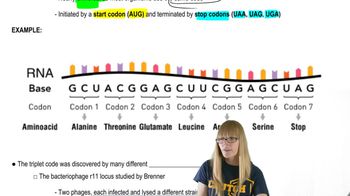Table of contents
- 1. Introduction to Genetics51m
- 2. Mendel's Laws of Inheritance3h 37m
- 3. Extensions to Mendelian Inheritance2h 41m
- 4. Genetic Mapping and Linkage2h 28m
- 5. Genetics of Bacteria and Viruses1h 21m
- 6. Chromosomal Variation1h 48m
- 7. DNA and Chromosome Structure56m
- 8. DNA Replication1h 10m
- 9. Mitosis and Meiosis1h 34m
- 10. Transcription1h 0m
- 11. Translation58m
- 12. Gene Regulation in Prokaryotes1h 19m
- 13. Gene Regulation in Eukaryotes44m
- 14. Genetic Control of Development44m
- 15. Genomes and Genomics1h 50m
- 16. Transposable Elements47m
- 17. Mutation, Repair, and Recombination1h 6m
- 18. Molecular Genetic Tools19m
- 19. Cancer Genetics29m
- 20. Quantitative Genetics1h 26m
- 21. Population Genetics50m
- 22. Evolutionary Genetics29m
17. Mutation, Repair, and Recombination
Induced Mutations
Problem 30b
Textbook Question
Textbook QuestionA fragment of a wild-type polypeptide is sequenced for seven amino acids. The same polypeptide region is sequenced in four mutants. Wild-type polypeptide N . . . Thr–His–Ser–Gly–Leu–Lys–Ala . . . C Mutant 1 N . . . Thr–His–Ser–Val–Leu–Lys–Ala . . . C Mutant 2 N . . . Thr–His–Ser–C Mutant 3 N . . . Thr–Thr–Leu–Asp–C Mutant 4 N . . . Thr–Gln–Leu–Trp–Ile–Glu–Gly . . . Determine the wild-type mRNA sequence.
 Verified Solution
Verified SolutionThis video solution was recommended by our tutors as helpful for the problem above
Video duration:
2mPlay a video:
Was this helpful?
Key Concepts
Here are the essential concepts you must grasp in order to answer the question correctly.
Genetic Code
The genetic code is a set of rules that defines how the sequence of nucleotides in mRNA is translated into the sequence of amino acids in a polypeptide. Each amino acid is specified by a codon, which is a sequence of three nucleotides. Understanding the genetic code is essential for determining the mRNA sequence that corresponds to a given polypeptide sequence.
Recommended video:
Guided course

The Genetic Code
Transcription and Translation
Transcription is the process by which the DNA sequence of a gene is copied into mRNA, while translation is the subsequent process where ribosomes synthesize proteins based on the mRNA sequence. To determine the wild-type mRNA sequence from the polypeptide, one must understand how these processes work together to convert genetic information into functional proteins.
Recommended video:
Guided course

Translation initiation
Mutations
Mutations are changes in the nucleotide sequence of DNA that can lead to alterations in the corresponding polypeptide. Analyzing the differences between the wild-type and mutant polypeptide sequences helps identify specific mutations and their potential effects on protein function. This understanding is crucial for reconstructing the wild-type mRNA sequence from the provided polypeptide data.
Recommended video:
Guided course

Mutations and Phenotypes

 4:29m
4:29mWatch next
Master Induced Mutations with a bite sized video explanation from Kylia Goodner
Start learningRelated Videos
Related Practice


